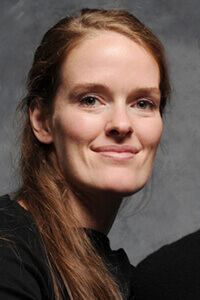November 9, 2020
 Simone LaBonté ’06 is in her sixth year as the Director of Person Centered Practices at New Directions Inc. Under her leadership, New Directions Inc. partnered with local organization Woodbury Thrives to construct a community garden at a New Directions Inc. residential home in Woodbury, creating a resource for the home’s residents and the greater community.
Simone LaBonté ’06 is in her sixth year as the Director of Person Centered Practices at New Directions Inc. Under her leadership, New Directions Inc. partnered with local organization Woodbury Thrives to construct a community garden at a New Directions Inc. residential home in Woodbury, creating a resource for the home’s residents and the greater community.
Tell us more about your community garden project and your work with New Directions. How did the garden come to be?
I work for New Directions Inc., a small company that helps people with developmental disabilities lead fulfilling lives. People with disabilities are often isolated or segregated from their neighbors. The community garden is one of the ways New Directions is trying to change that and create connections with the local community.
Three of the men that New Directions serves and I partnered with Woodbury Thrives, a community building organization, and applied for a Statewide Health Improvement Partnership (SHIP) grant through Washington County. They ultimately funded the first year of a community garden project in the pre-Covid era (spring of 2019). The garden was hosted by the three guys–it was built and planted in their yard. We invited neighbors to a community get-together by going door to door to introduce ourselves and our idea. We also hung flyers and handwritten notes on people’s doorknobs.
We were overjoyed by the overwhelming support and enthusiasm the neighbors showed toward the garden and the longing to connect with one another. We were hoping that 10-12 people would stop by to our community get-together. Over 50 showed up! People gave their input about what to grow and the design of the garden. Through the next couple of weeks, under the leadership of two Washington County Master Gardeners, we built six raised beds, filled the beds with dirt, built a pergola and planted seedlings. Neighbors were encouraged to come to the garden whenever they could, but Friday night was gardening night. Anywhere from 5-20 people would show up to connect, pull the occasional weed and harvest vegetables. Oftentimes, families would come together to join us at the community garden. The season culminated in a potluck.
 Through the community garden, neighbors got to know each other, including the three men served by New Directions. The neighborhood is far more connected. As one person described, “I feel like it just brings people together and if you have more ownership of your community, you’re watching out for each other more, it’s a safer feeling.”
Through the community garden, neighbors got to know each other, including the three men served by New Directions. The neighborhood is far more connected. As one person described, “I feel like it just brings people together and if you have more ownership of your community, you’re watching out for each other more, it’s a safer feeling.”
How did you get there? Where did you attend college? Are there some career moves or other key experiences or relationships that have inspired you?
I attended college at Skidmore, majoring in International Relations and minoring in Spanish, Anthropology and Studio Art. After graduating from Skidmore College, I spent three and a half years serving in the Peace Corps in Panama in two different roles. When I returned to Minnesota and started looking for jobs, I bumped into Laurie Kigner, a mom of a childhood friend who also went to MPA. It was then when I learned about the amazing work that New Direction does and found out about a professional opportunity to work with them. As a small company, New Directions has allowed me to take initiative in many different areas and actively promote positive change: designing the website, reimagining processes, directly supporting people we serve, training staff, and facilitating team conversations about the direction in which people would like to take their life.
How did your MPA experience prepare you for your life today? How did MPA inspire you to dream big and do right?
Mounds Park fostered my curiosity to learn, be creative and challenge myself. Without MPA’s strong arts program, abundant extracurriculars and an emphasis in strong academic writing skills across subjects, I wouldn’t be where I am today.
What’s your favorite memory from your time at MPA?
Mounds Park cultivated my joy of photography. I used study halls to be in the dark room or, more often, I would walk into different classrooms throughout the school and start taking pictures. Writing about this now, I can’t believe I was allowed to do that! I ended up getting great candid shots. After editing the photos, I would sometimes interview teachers about what was going on and write story captions for the yearbook. Through this, I learned from a Kindergarten teacher how important play is and, from a biology teacher, about different styles of leadership.